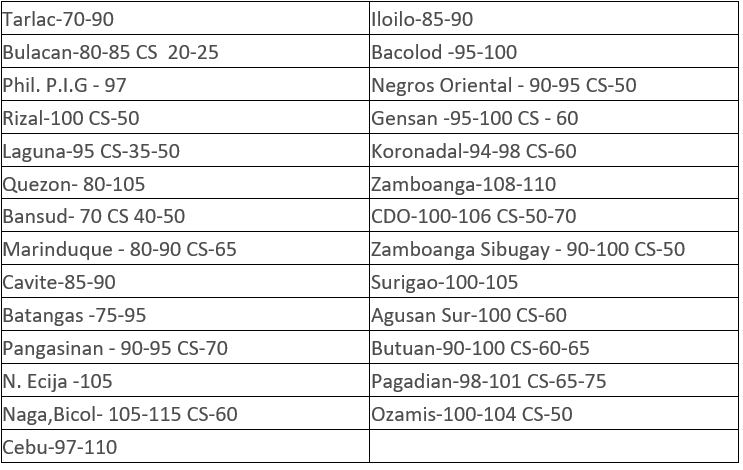



Genesus Global Marketing Report: SE Asia - November 2019

Philippines
As of 1 October 2019, the total inventory of swine in the country was estimated at 13.01 million heads. This represents a decrease of 0.9 percent compared with the previous year’s stocks of 13.13 million heads.
In backyard farms, swine inventory at 8.20 million heads decreased by 1.7 percent from the previous year’s count of 8.34 million heads. On the other hand, stocks in commercial farms at 4.81 million heads increased by 0.6 percent from the previous year’s level of 4.78 million heads.
Among the regions, Central Luzon recorded the highest swine inventory of 2.21 million heads. This was followed by CALABARZON and Western Visayas with stocks of 1.57 million heads and 1.27 million heads, respectively. The combined stocks of these three regions accounted for 38.8 percent of the country’s total swine inventory.
The Philippines reported an official update on the African Swine Fever (ASF) progress to the OIE. The virus is now officially reported from Pangasinan province as well as Manila, both on Luzon Island.
In what is the 2nd round of updates to the OIE, the report contains 9 new outbreak locations, spread out over Pangasinan province and Manila.
In Manila, the Philippines confirmed seven different outbreaks from Quezon City, which is in Manila’s 2nd District. In all cases, this was about backyard farms in smaller village units. The total amount of animals that had to be culled was 4,919, according to these figures.
In addition, the Philippines confirmed two outbreaks to the OIE in the northern province of Pangasinan, in the locations Apalen and Baloling. Here in total 212 pigs had to be culled.
Also outbreaks have already been reported from Bulacan and Cavite provinces. The FAO website also reports that the provinces Nueva Ecija and Pampanga are infected. Exact data about what is going on in those provinces, however, are not available yet from the OIE.
At the first update round at the OIE, the Philippines reported that their first outbreak occurred on 25 July, in Rodríguez and Antípolo, in Rizal province, east of Manila. That report included seven outbreaks in backyard facilities.
In total 62,000 animals have died or have been culled in relation to ASF
Liveweight pig price has deceased, see below.

Vietnam
The liveweight price of the pig now is 74,000 – 82,000 vnd/kg in the North; 70,000 – 75,000 vnd/kg in the centre and 69,000 – 76,000 vnd/kg in the South. The average liveweight pig price will be around 73,000 vnd/kg. The pig price has gone up very fast, the farmer’s that think they got ASF are selling their pigs down to a light weight to off load prior to dying or being culled.
Farmers are also selling illegally over the border to China as the Vietnam Government tries to prevent the pork being shipped to China, as Vietnam has it’s own huge shortage of pork. Officially, pork export is not allowed.
Until now, the government is saying the pig inventory has decreased only by 20% of total herd size in an attempt to keep the pig price low, but according to local industry experts this is not true and the pig price is still forecast to rise.
On the other hand, the government is allowing pork imports in huge quantities. The top five countries that exported pork to Vietnam are: Brazil, Poland, USA, Belgium and Spain.
Other Headlines in Vietnam:
- More than 1,200 GGP Genesus Inc. pigs were imported to Vietnam.
- ADM group opened the fifth feed mill in Vietnam.
- The government tries to save enough pork in Vietnam for Lunar New Year 2020.
- Mavin Group discontinued pigs supply due to ASF.
- An Giang province: Pigs smuggled from Cambodia to Vietnam.
- Masan MEATlife Affected by the Pork Crisis.
- Livestock Ha Noi shifts from backyard farming to intensive farming.
Thailand
Pig price is stable in Thailand with a slight increase in the 4th quarter reaching 62-65 baht/kg ($2.1-$2.2/kg).
Stronger price forecast, as Cambodia is resuming live-pig imports estimated at 2,000 pigs/day. However, actual figures could be higher as Cambodian traders admitted that part of live-pig imports from Thailand are being shipped further to Vietnam, which is facing a severe shortage of pork.
If the country remains free from African swine fever (ASF), its pig industry could benefit from exports of live-pigs and pork to Hong Kong. Hong Kong’s Food and Health Secretary Sophia Chan has approached Thai livestock authorities, expressing interest in importing live-pigs or pork from Thailand. China used to supply 4,000 pigs/day to Hong Kong, but after being hit by ASF, its exports to the island plunged to only 1,700 pigs/day.
Thai chicken processor invests in pig farm, abattoir
Star Food Group, a major chicken processor in Thailand, is investing in a new pig farm (10,000 sows capacity) and an abattoir with a processing capacity of 300 pigs/day. According to CEO Sakda Maneephan, the move is to establish a pork supply chain that is in compliance with international standards.
“It is an export oriented facility designed to utilise latest pig genetics to produce high quality pork for upscale markets in Thailand and exports,” said Mr Sakda.
The farm is being built and will soon be ready for 3,500 gilts in for first phase. Similar to the abattoir, the design of the production line is being undertaken and the equipment is being sourced from reputed supplies all over the world.









